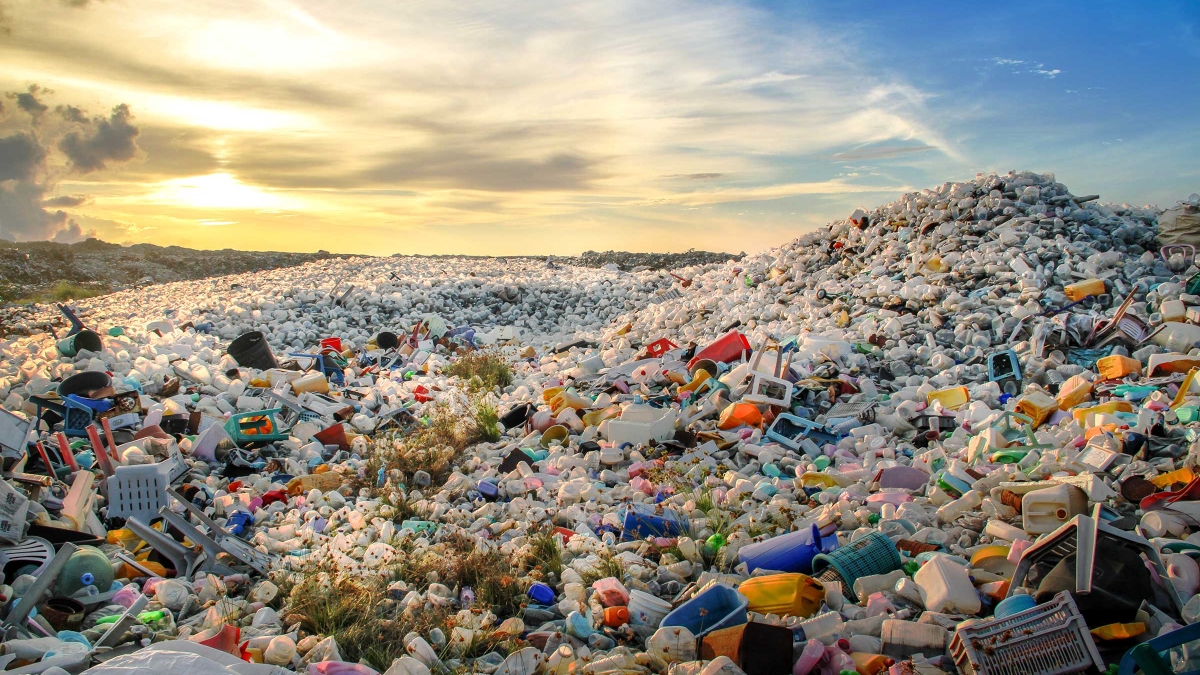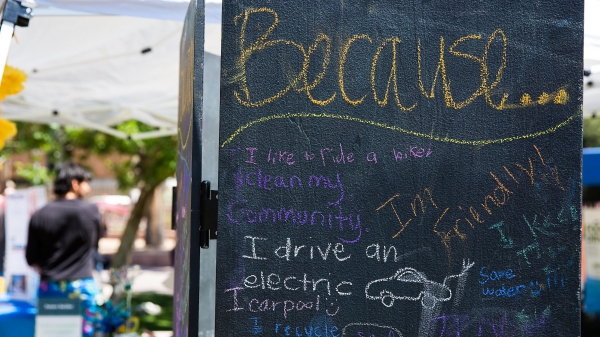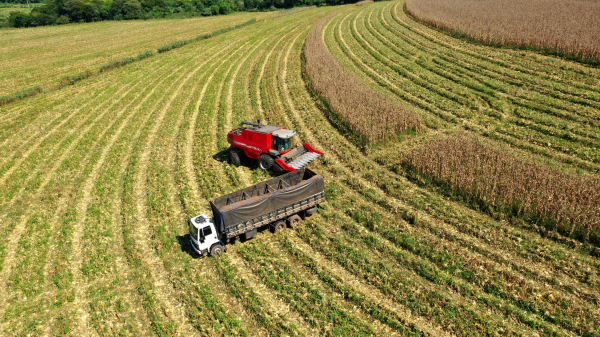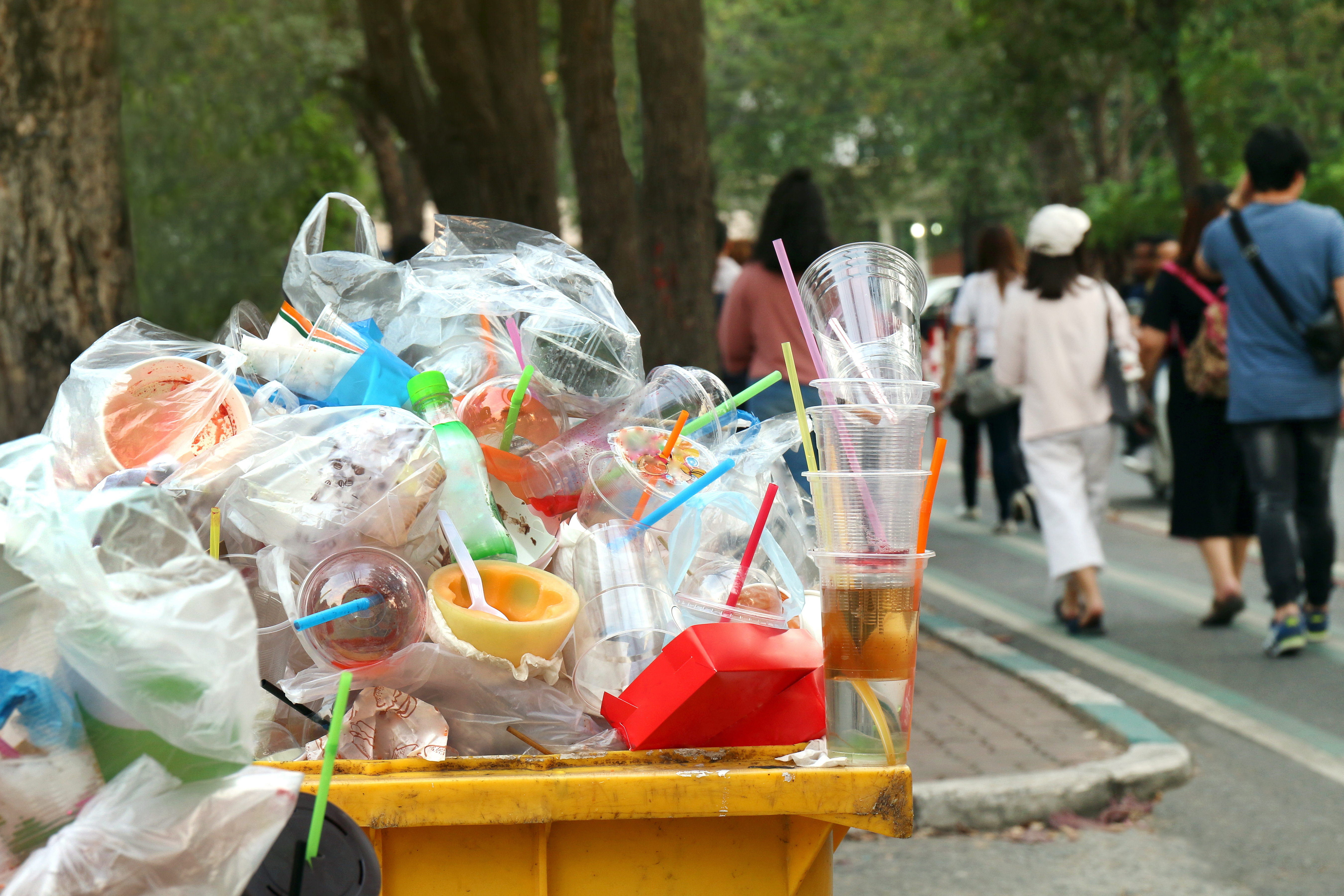The inconvenient consequences of a culture of convenience
Single-use plastics are negatively affecting the planet and the health of its creatures — including us

Single-use plastics — such as cups with straws, takeout containers and water bottles — are so common in our culture of convenience that we often don’t give them a second thought.
But their momentary utility is misleading: These items stick around a really long time.
Because of the way plastic is designed, “its afterlife is much longer than its useful lifespan,” said Rolf Halden, directorHalden is also a professor in the School for Sustainable Engineering and the Built Environment in the Ira A. Fulton Schools of Engineering at ASU. of the Biodesign Institute's Center for Environmental Health Engineering at Arizona State University. Plastic that we use for just a moment “has the potential to pollute for decades, centuries or millennia.”
Most plastic does not biodegrade, but instead breaks down into smaller and smaller pieces known as microplastics that are no more than 5 millimeters in diameter. Single-use plastics and their resulting microplastics cause harm in a network of ways — some that scientists are just beginning to recognize and understand. Though plastic production didn’t ramp up until the 1950s, this material has already pervaded our lands, seas and bodies.
A recent peer-reviewed study estimates that people have produced a total of 8.3 billion metric tons of plastic, and only 9 percent has ever been recycled. The rest has been incinerated, landfilled or littered.
Plastic pollution resulting from mismanagement can be obvious, like a plastic coffee cup rolling down the sidewalk in the breeze. It can also be unexpected, like microplastics in our drinking supply. Plastics crowds our lands and waters, creating complex and cascading problems — some related to human health.
Plastic pollution impacts: From land to sea
Plastics can be introduced to ecosystems on land in a variety of ways, including through litter or sewage sludge — a semi-solid byproduct of wastewater treatment that’s often applied to cropland as fertilizer. Microplastics in wastewater, from sources including contact lenses and microfibers from synthetic clothing, often end up in sewage sludge and subsequently in soil. Once introduced to dirt, microplastics can filter down into water tables or enter rivers and streams, and eventually end up in our drinking water.
In late 2017, German researchers released a report describing broad impacts that microplastics can have on terrestrial ecosystems and their species. They said the threats of microplastics on land may be underestimated, but that more research is needed.
Far more attention has been paid to the effects of microplastics in the ocean. The ocean supplies half of our oxygen, absorbs 50 times more carbon dioxide than our atmosphere, regulates our climate, and provides food and recreational opportunities.
When the ocean suffers, so do people.
All five of the ocean’s massive gyres — systems of circular ocean currents — are pulling in and concentrating discarded trash in what are colloquially known as garbage patches. Scientists know the most about the Great Pacific Garbage Patch, between Hawaii and California, a “soupy” swathe of ocean permeated with microplastics and scattered with larger items such as fishing nets.
Photo by Shutterstock
Plastics enter the ocean in various ways, often through rivers that can carry waste over long distances.
“In places that don’t have really good waste disposal services — like a lot of countries in the South Pacific and Asia — (residents) don’t have people that come to their house and pick up their garbage. Or if that service is offered, it’s very expensive,” said Beth Polidoro, assistant professor of environmental chemistry in the School of Mathematical and Natural Sciences.
Without better options, Polidoro said, people often throw trash directly into rivers or oceans, or they litter on land and the garbage eventually makes its way into waterways. Even in areas that have adequate waste management systems, littering is an issue. This is not just a problem in developing nations.
Plastics that end up in the ocean can endanger biodiversity by entangling wildlife, which causes strangulation, injury, amputation or drowning. Some sea animals eat plastic accidentally or mistake it for a food source — either because it smells like food or looks like food. For example, Galapagos green turtles are known to eat bags because they resemble their favorite meal: jellyfish.
“Plastic debris ingested by turtles can cause intestinal blockage resulting in malnutrition, reduced growth rates and even death,” according to the United Nations Environment Programme. “Perhaps most distressingly, turtles can starve to death because they feel full after swallowing plastic debris.”
More than 220 animal species — not just turtles — have been documented consuming plastics. In June 2018, a pilot whale washed ashore on a Thai beach after swallowing 80 bags. Nearly all seabirds have eaten plastics. Even coral are known to eat microplastics, and, a study shows, find some plastics to be tasty.
Ingested microplastics can transfer harmful chemicals into an organism’s bloodstream or tissues. Plastics not only contain chemical additives, such as flame retardants and colorants, but they also act like a sponge for toxins that are dumped into the ocean. When microplastics are eaten by ocean life, the chemicals “can move into tissue through the metabolic processes, even if (the organisms) are excreting the plastic molecules themselves,” Polidoro said.
At this time, the extent to which these toxins from ingested microplastics affect wildlife is unknown. Studies conducted on a variety of aquatic organisms under laboratory conditions have shown negative physiological reactions to occur after exposure to high levels of microplastics. These observations do not necessarily translate to wild and farmed seafood, however — and it’s more difficult for scientists to measure exposure and impact in populations not under their control.
Nevertheless, Halden says that we need to “come to grips with this or else it will come back to harm us in a potentially bad way.”
Plastic pollution impacts: Human health
Contaminated seafood is just one way that plastic pollution has the potential to negatively affect human health. Scientists have discovered microplastics throughout our soils, seas, drinking water and urban air, but the study of how these particles affect people is a budding field.
Polidoro believes that the health impact is massive.
“It’s not just about saving the planet, it’s about reducing contamination in our own bodies,” she said. “Environmental health is public health.”
A recent study found that 83 percent of tap water samples from more than a dozen countries contain microplastics — mostly plastic fibers that wash off synthetic clothing (like a fleece jacket) into wastewater. These fibers are too small to be completely filtered out of treated water, which is either reused or released into rivers and streams.
Another study discovered that more than 90 percent of the world’s most popular bottled-water brands are polluted with microplastics, prompting the World Health Organization to launch a review of the risks in March 2018.
What’s the big deal about plastic straws?
Though plastic pollution is a complex issue, a rather simple item has been grabbing recent headlines: plastic straws. Environmentalists and some major corporations — including American Airlines, Starbucks and Live Nation — vow to eliminate their use.
An estimated 8 million metric tons of plastic ended up in the ocean in 2010 — the equivalent of five bags of plastic sitting on every foot of coastline in the world. Only a small portion of this waste is estimated to be plastic straws.
“The movement is largely symbolic,” said Carole Mars, director of innovation and technical development at The Sustainability Consortium, a group created in 2009 by ASU and the University of Arkansas to transform the consumer-goods industry. “It’s finally something that the broader public at large has been able to get their arms around when thinking about ocean plastics.”
Photo by Pixabay
Straws aren’t recyclable, and because they’re light and small, they easily travel into sensitive landscapes and oceans — where they might, say, lodge themselves into the nose of a sea turtle, or worse.
Many environmental organizations that focus on ocean health, including Lonely Whale, co-founded by actor and activist Adrian Grenier, have given voice to the issue of plastic pollution through straws.
“We have an addiction to this material that’s so useful but so destructive,” Grenier said about plastic. “Straws represent that really small, incremental opportunity to make change. Straws are arguably unnecessary — they’re elective or they’re optional except in the regard to the disability communityMany people with disabilities require straws to drink. Biodegradable or reusable straws are not always safe or practical substitutes.. If we can't change that, then how are we going to truly tackle the bigger problems?”
The lowdown on plastic recycling
Recycling is not a catchall solution — but it is an important part of a circular economy that helps spent products find new life. Not all plastics, however, can easily be recycled.
“Plastics can be challenging to recycle because of the wide variety of uses, additives and blends that are used in a multitude of products, as well as the fact that there are material properties that can limit the number of times that products can be recycled,” according to the report “The Chinese import ban and its impact on global plastic waste trade.”
The plastic straw offers a good introduction to some of the pitfalls of recycling. Straws are typically made from polypropylene, a flexible plastic (labeled with the No. 5 symbol) commonly used to make yogurt cups and other food-safe containers. Few recycling centers in the U.S. accept polypropylene, although Phoenix currently does.
Even in recycling facilities that do accept polypropylene, straws are too small to be captured during the separation of materials.
“Anything smaller than 2.5 inches in diameter falls through the cracks at our recycling facilities,” said Lucas Mariacher, zero waste coordinator for the city of Phoenix. If straws happen to make it through the sorting process, they likely end up as contamination in other streams of materials, such as paper.
According to Alana Levine, interim director for ASU’s Zero Waste department, recycling straws would be a “massive supply-chain problem.” Homes, businesses and public spaces would need to implement a separate bin strictly for plastic straws, and consumers would need to be educated on using those bins. A whole operation would have to be set up to collect those straws, transport them to a recycling facility and put them in bales. And at the end of the day, recycling is a business — someone would need to buy those bales and turn the straws into new products. It’s an unlikely and costly scenario.
Photo by Shutterstock
What is accepted for recycling varies from place to place, so it’s important to check your local facility’s policies. In addition to recycling clean and unbagged items, Mariacher recommends that Phoenix residents review the Top 10 in the Bin flyer that illustrates the best items to recycle locally. Knowing the basics can help people avoid a “wishful recycling mentality” — putting anything in the blue bin that looks recyclable.
As a general guideline, most U.S. cities recycle Nos. 1 and 2 plastics — think water bottles, milk jugs and liquid soap containers. Nos. 3 through 7 are less commonly recycled.
Phoenix’s recycling facilities currently divert Nos. 1, 2 and 5 plastics from landfills. All others, regardless of whether they are put in recycling bins, will be landfilled because there is no market for them. This is a recent change, as China used to be a major buyer of the world’s plastics up until that country’s ban on importing foreign plastic waste took effect this year.
To counter this ban, the city of Phoenix wants to build a recycling facility on its resource innovation campus that could process plastics 3 through 7. This summer, it accepted proposals from companies who want to be a part of this solution.
“Our goal is to create a local circular economy where we can keep the stuff within Phoenix markets instead of sending it overseas or shipping it to Mexico or Canada,” Mariacher said.
Weighing the alternatives
A growing number of restaurants, cafes and bars are looking for alternatives to single-use plastics, including straws and cups, to help reduce their environmental impact. However, alternatives must be evaluated for cost and feasibility. In the case of straws, businesses are finding that a “straws upon request” policy helps offset higher costs associated with alternatives because few people request them.
Businesses considering a switch to more sustainable products also need to be aware of “greenwashing.” Some manufacturers want to make their products seem more eco-friendly than they actually are, so they present wrong or misleading information.
“The restaurants are coming from the right place — they want to do the right thing,” said Mars. “But greenwashing is just so easy.”
PLA, a plant-based plastic, is often marketed as compostable and used as an alternative to plastic straws, cups and other containers. On the surface, this seems great — but PLA will only decompose in industrial composting facilities, a rare service in the United States. PLA won’t break down in backyard compost piles because it requires certain conditions such as high heat to degrade.
Since PLA feels and looks like regular plastic — except for maybe a green stripe on some products — consumers commonly throw them in recycling bins. Unfortunately, PLA can’t be recycled, and it’s actually considered contamination in a plastic recycling stream because it’s made of different materials than fossil-fuel-based plastics. More often than not, PLA products must be landfilled.
Phoenix has a composting center that currently accepts yard waste, untreated wood and cow manure, but this facility does not accept PLA products. Technically, PLA would break down under the conditions present at the facility, but Mariacher said that these products must be filtered out because the sorting staff has no way of determining whether they are actually compostable or not. A PLA straw, for example, often looks the same as a regular plastic straw.
Even if PLA products are marked with a green stripe, Mariacher said they still can’t be accepted because there’s currently no guarantee that all green-striped plastics are certified by the Biodegradable Products Institute.
Some communities are developing small-scale composting operations that accept PLA, such as Recycled City in Phoenix. Recycled City works with a handful of local businesses and households to turn their food waste into nutrient-rich soil.
Danielle Leoni, co-owner and executive chef of The Breadfruit & Rum Bar in downtown Phoenix, uses Recycled City to compost PLA straws used in cocktails that need them.
“Anyone who’s had a mojito without a straw knows it’s not a good idea,” she said with a laugh.
Leoni said the service costs The Breadfruit $20 per week, but that composting brings great value to the restaurant.
“Committing to composting became a vehicle for us to analyze our process of prepping and making food,” she said. “We were able to take note of what we were throwing away and develop systems to repurpose product that would have been wasted. Less food being thrown away or composted means we are reducing our cost of goods sold and improving our bottom line.”
Levine recommends that businesses first reduce single-use plastics where possible, then incorporate into their bottom line a composting program that accepts PLA so they can responsibly dispose of some of those harder-to-eliminate items. To share costs, she said, restaurants next to each other can centralize their composting — but it’s important for staff and consumers to be educated about what can go into compost bins because there’s a “zero allowable contamination rate.”
Alternative straws: From paper to bamboo
Aardvark is the only U.S. manufacturer of paper straws, which are compostable even in backyards. Demand is high: In July 2018, Aardvark advised businesses to plan ahead for their orders because of significant backlog. In August, the company announced that they were acquired by Hoffmaster Group, Inc. which would allow them to ramp up supply.
Other businesses are converting to other alternatives: bamboo, glass, metal and even hay straws. Seattle became the first U.S. city to ban plastic straws, but in most cities this action is voluntary.
Nicole Darnall, associate dean of ASU’s School of Sustainability, said that voluntary action will make a difference, but the shift will plateau.
“You need something else to motivate greater thresholds of change,” she said, suggesting policy changes or monetary incentives. If businesses charged for convenience items like straws in iced coffees or offered discounts to consumers who bring in their own cups, it would make it cheaper to do the right thing.
“We don’t want (scientists and) celebrities to be the only people talking about this. We want university professors talking, students talking, media saturation — social media and news — so that more and more people become aware.”
— Joni Adamson, director of ASU’s Environmental Humanities Initiative
Darnall believes that our culture needs to shift so that we rely less on convenience items and more on reusable items.
“Why is it that we treat a straw any different than we treat a piece of silverware?” she said. Anybody who is concerned about the hygiene of reusable straws or other items should carry their own, Darnall suggested.
Aramark, a major food supplier at ASU, is developing strategies to reduce disposable plastic on campus. Krista Hicks, sustainability manager for Aramark at ASU, said that single-use plastic straws and stirrers have already been eliminated from most residential dining halls and catering, and alternatives such as wooden stirrers and paper straws will be implemented. Moving forward, Hicks said the company is “launching a holistic strategy to address single-use plastics overall.”
Designing an alternative to straws
Starbucks is an example of a corporation that is designing its way around plastic straws. In July, the company announced it would phase them out by 2020, instead using a new sippy-cup-like lid for most cold beverages.
“The strawless lid is made from polypropylene, a commonly accepted recyclable plastic that can be captured in recycling infrastructure, unlike straws which are too small and lightweight to be captured in modern recycling equipment,” the company said on Twitter.
While this move has been widely celebrated, it would be better news if it weren’t for the fact that polypropylene, or No. 5 plastic, is seldom accepted for recycling in the U.S. — especially since China will no longer take it. Starbucks operates 24,000 stores in more than 75 markets, including countries that don’t have well-developed recycling operations. A huge portion of these new lids may end up in landfills or polluting the environment, regardless of positive intentions.
“As always, the No. 1 thing that is going to be best for any triple bottom lineA “triple bottom line” is a sustainability framework that considers a business’s social, environmental and economic impact — often referred to as people, planet and profit. and best for any scenario is elimination (of single-use plastics),” Levine said, reiterating Darnall’s point that consumers should be encouraged to carry reusable items.
‘One planet. One.’
It will take effort across the board, from policy changes to individual actions, to shift the culture of convenience.
Joni Adamson, director of ASU’s Environmental Humanities Initiative, said that education is key and that she’d like to see the discussion about plastic pollution flourish across all platforms.
“We don’t want (scientists and) celebrities to be the only people talking about this,” she said. “We want university professors talking, students talking, media saturation — social media and news — so that more and more people become aware.”
People have more power than they think they do to create change, Polidoro said.
“We can all point fingers, but it’s really up to us to change our habits. We just have to make the effort instead of feeling complacent or powerless,” she said.
And the motivation is clear.
“At the end of the day, we only have one planet,” Darnall said. “One.”
Top photo by Shutterstock
More Environment and sustainability

Earth Day celebrations focus on making our planet a priority
On April 22, Earth Day is celebrated across the country and in nearly 193 countries around the world. Arizona State University will be part of that celebration. The university has planned more…

ASU scientist studies how bans, regulations on food technology affect consumer acceptance, perceptions
How do people process scientific developments with outside influences, warnings, biases and others’ opinions filtering in? That’s the question Caitlin Drummond Otten, environmental social scientist…

ASU team's research leads to new law protecting mobile-home dwellers
Arizona Gov. Katie Hobbs signed a law earlier this month that guarantees mobile-home owners’ right to install cooling measures, thanks in large part to the work of an Arizona State University team.…


